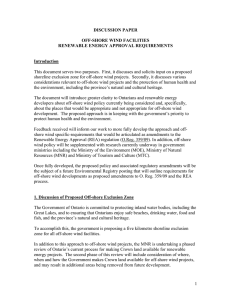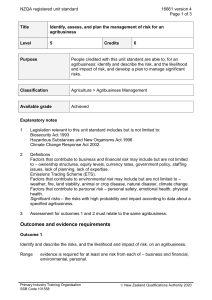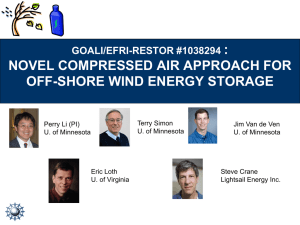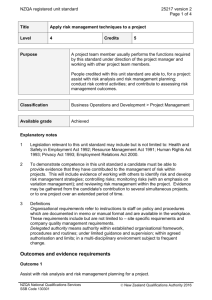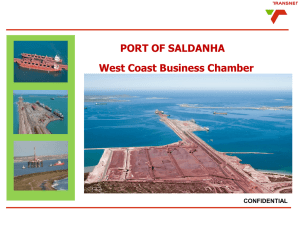24750 Explain and demonstrate basic safety for the off
advertisement
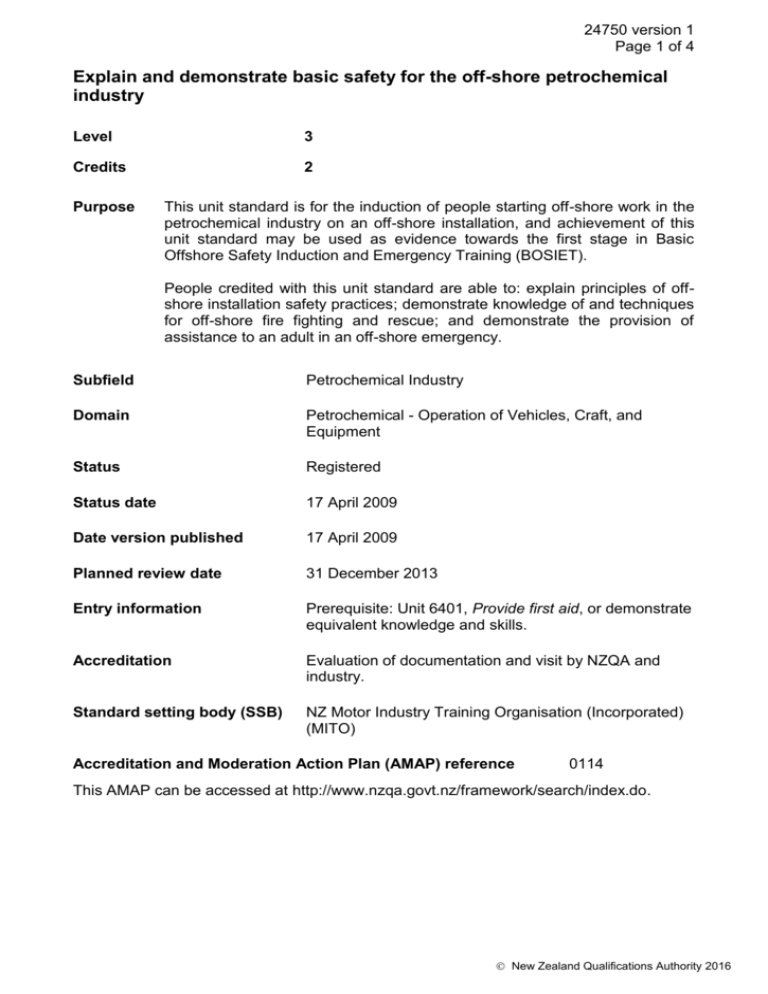
24750 version 1 Page 1 of 4 Explain and demonstrate basic safety for the off-shore petrochemical industry Level 3 Credits 2 Purpose This unit standard is for the induction of people starting off-shore work in the petrochemical industry on an off-shore installation, and achievement of this unit standard may be used as evidence towards the first stage in Basic Offshore Safety Induction and Emergency Training (BOSIET). People credited with this unit standard are able to: explain principles of offshore installation safety practices; demonstrate knowledge of and techniques for off-shore fire fighting and rescue; and demonstrate the provision of assistance to an adult in an off-shore emergency. Subfield Petrochemical Industry Domain Petrochemical - Operation of Vehicles, Craft, and Equipment Status Registered Status date 17 April 2009 Date version published 17 April 2009 Planned review date 31 December 2013 Entry information Prerequisite: Unit 6401, Provide first aid, or demonstrate equivalent knowledge and skills. Accreditation Evaluation of documentation and visit by NZQA and industry. Standard setting body (SSB) NZ Motor Industry Training Organisation (Incorporated) (MITO) Accreditation and Moderation Action Plan (AMAP) reference 0114 This AMAP can be accessed at http://www.nzqa.govt.nz/framework/search/index.do. New Zealand Qualifications Authority 2016 24750 version 1 Page 2 of 4 Special notes 1 Performance of the elements of this unit standard must comply with site requirements, the Basic Offshore Safety Induction and Emergency Training BOSIET Standard, and the following legislation and guidelines: Health and Safety in Employment Act 1992; Resource Management Act 1991; New Zealand Resuscitation Council Level1/2/3 Guidelines (2006) and any subsequent amendments, published by the New Zealand Resuscitation Council Inc; available from New Zealand Resuscitation Council, Wellington School of Medicine, PO Box 7343, Wellington 6242. 2 Candidates for this unit standard must be medically fit and capable of participating fully in the physically demanding elements. 3 Candidates may use achievement of this unit standard, and Unit 4143, Conduct sea survival operations, and Unit 9580, Demonstrate basic helicopter safety in an offshore petrochemical workplace, as evidence for the first stage in BOSIET. 4 Definitions BOSIET means Basic Offshore Safety Induction and Emergency Training the petrochemical industry common induction process. For details please refer to http://www.opito.com. Site requirements mean the site specific documented methods for performing work activities and include health, safety, environmental, and quality management requirements. They may refer to manuals, codes of practice, or policy statements. Elements and performance criteria Element 1 Explain principles of off-shore installation safety practices. Performance criteria 1.1 Off-shore hazards are identified, their risks assessed, and the consequences of failure to control them are outlined in accordance with site and legislative requirements. Range pressure, motion, chemical, electrical, gravity. 1.2 The control of off-shore hazards is explained in terms of waste disposal and protecting the environment in accordance with site and legislative requirements. 1.3 The regulation and management of off-shore safety is explained in accordance with site, and legislative requirements. Range international, national, industry. New Zealand Qualifications Authority 2016 24750 version 1 Page 3 of 4 1.4 Procedures for living and working off-shore are explained in relation to individual responsibilities in accordance with site requirements. Range 1.5 off-shore routines, working routines, involvement in safety, communicating safety, reporting accidents. Health and fitness requirements are explained in accordance with site requirements. Range medical standards, prescribed medicines, alcohol, substance abuse. Element 2 Demonstrate knowledge of and techniques for off-shore fire fighting and rescue. Performance criteria 2.1 Common causes of fires onboard off-shore installations are identified and the nature of the fires is explained in accordance with off-shore site requirements. 2.2 Procedures in the event of a fire on an off-shore installation are explained and demonstrated in accordance with off-shore site requirements. Range procedures – raising the alarm, operating hand held portable equipment, use of fire blankets; hand held portable equipment – water and/or foam, dry chemical, CO2. 2.3 Self rescue techniques, with and without respiratory protection, from areas subject to smoke and heat are explained and demonstrated in accordance with off-shore site requirements. 2.4 Small group escape techniques with respiratory protection from an area subjected to smoke and heat are explained and demonstrated in accordance off-shore site requirements. 2.5 Self rescue techniques with a smoke hood are demonstrated in accordance with off-shore site requirements. Range 2.6 reduced visibility, completely obscured. Small group rescue techniques with a smoke hood are demonstrated in accordance with off-shore site requirements. New Zealand Qualifications Authority 2016 24750 version 1 Page 4 of 4 Element 3 Demonstrate the provision of assistance to an adult in an off-shore emergency. Range real or simulated emergency. Performance criteria 3.1 Cardiopulmonary resuscitation techniques are demonstrated on an adult in an off-shore emergency in accordance with the New Zealand Resuscitation Council guidelines and off-shore site requirements. 3.2 Treatments for conditions common to off-shore emergencies are demonstrated on an adult in accordance with off-shore site requirements. Range hypothermia, bleeding, burns. Please note Providers must be accredited by NZQA, or an inter-institutional body with delegated authority for quality assurance, before they can report credits from assessment against unit standards or deliver courses of study leading to that assessment. Industry Training Organisations must be accredited by NZQA before they can register credits from assessment against unit standards. Accredited providers and Industry Training Organisations assessing against unit standards must engage with the moderation system that applies to those standards. Accreditation requirements and an outline of the moderation system that applies to this standard are outlined in the Accreditation and Moderation Action Plan (AMAP). The AMAP also includes useful information about special requirements for organisations wishing to develop education and training programmes, such as minimum qualifications for tutors and assessors, and special resource requirements. Comments on this unit standard Please contact the NZ Motor Industry Training Organisation (Incorporated) (MITO) info@mito.org.nz if you wish to suggest changes to the content of this unit standard. New Zealand Qualifications Authority 2016


